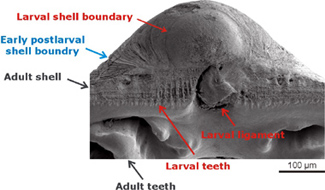Biology

A key to understand bivalve biodiversity and evolution
There are ca. 20.000 living species of bivalve molluscs, one of the oldest and evolutionary most successful classes of invertebrates. An ongoing research project at the Paleontology Area of the UAB Department of Geology deals with the question of how ontogeny and biodiversity evolved in these molluscs. The results can explain the existence of convergent traits in unrelated phylogenetic lineages.
References
Malchus, N; Waren, A, Shell and hinge morphology of juvenile Limopsis (Bivalvia : Arcoida) implications for limopsid evolution, MARINE BIOLOGY RESEARCH, 1 (5): 350-364 NOV 2005.
There are ca. 20.000 living species of bivalve molluscs, one of the oldest and evolutionary most successful classes of invertebrates. An ongoing research project at the Paleontology Area of the UAB Department of Geology deals with the question of how ontogeny and biodiversity evolved in these molluscs. The results can explain the existence of convergent traits in unrelated phylogenetic lineages.
Nikolaus Malchus
Department of Geology
Universitat Autònoma de Barcelona
Bibliography
1 Malchus, N. 2004a. Shell ontogeny of Jurassic bakevelliid bivalves and its bearing on bivalve phylogeny. Acta Palaeontologica Polonica 49: 85-110.
2 Malchus, N. 2004b. Constraints in the ligament ontogeny and evolution of pteriomorphian Bivalvia. Palaeontology 47: 1539-1574.
3 Malchus, N. and Warén, A. 2005. Shell and hinge morphology of juvenile Limopsis (Bivalvia: Arcoida) - implications for limopsid evolution. Marine Biology Research 1: 350-364.
4 Smith KK, 2003. Time?s arrow: heterochrony and the evolution of development. International Journal of Developmental Biology 47: 613-621 (2003)
2024 Universitat Autònoma de Barcelona
B.11870-2012 ISSN: 2014-6388
